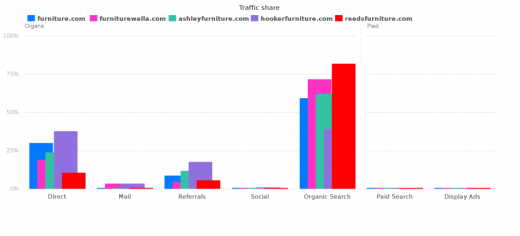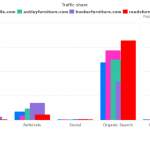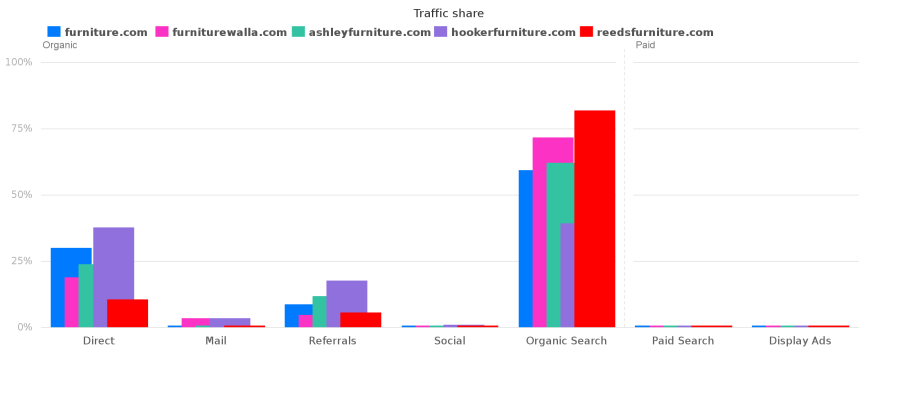Competitive Intelligence: The Art of Making Informed Decisions
May 2, 2016

All online businesses use Google Analytics to analyze their performance on a regular basis. From time to time they also take a look at their competitors’ activity to avoid surprises. But the question is, should we integrate competitive intelligence in our business processes and make it an ongoing process?
I maintain that doing competitive landscape research is as important as tracking your own performance, because you can learn what has worked for your rivals and benefit from their success and mistakes.
In this article I’ll show you how you can easily track your competitors’ behavior without spending hours on research and keep up to date with market shifts. I will also provide a proper explanation of how to get all the necessary data on your rivals with the help of competitive intelligence tools, and interpret that data so that you can make informed, strategic decisions.
Get to know your global and local competitors in Google search
I’d like start with a simple yet very important question: who are your competitors?
It sounds more than evident, but when it comes to identifying online competitors, there is often room for a lot of misunderstandings and mistakes.
You online competitors are domains that appear in Google SERPs for the same keywords for which you want your website to be visible. These domains are likely to steal your traffic and, as a consequence, your clients. Traffic coming from Google search is among the top sources from which businesses receive visitors, according to data from SimilarWeb:

As far as this channel comprises enormous opportunities for your business, you should know it inside and out! That is why in this article I will focus on how to embrace all the potentials of this source with the help of competitor research.
By offering consultancy on a regular basis I’ve learned that, in the majority of cases, businesses are not aware of the competitors with whom they’re appearing in search results for the same keywords. So, when it comes to identifying your rivals in search, I highly recommend that you utilize special tools. Without knowing the right solutions, competitor research can turn into a nightmare. If you’ve never heard about competitive intelligence tools, then you can easily spend weeks figuring out with which domains you’re appearing for the same keywords in Google search results.
Long story short, I advise that you use the following competitive intelligence tools: SEMrush, Serpstat, SpyFu, and Searchmetrics. These tools map out your competitors in only a few clicks, and all you need to do is type your domain name in, and analyze your list of rivals.
To use an example, let’s imagine that I’m the owner of a medium-size e-commerce store – furniture.com. I offer around 1,000 different products, and I need to know which of them are most and least competitive in Google search results in general, as well as in which particular locations I have a physical presence. Based on this data, I can decide where my business should move and how to avoid a serious loss of time and money.
To define my general online competitors for furniture.com, I used SEMrush. With the help of SEMrush I learned that the two main online competitors of furniture.com are bassetfurniture.com and americanfreight.us. In fact, any of the tools mentioned above can help you to identify your general online competitors by your number of shared keywords. Moreover, they take into account a domains’ size, which is also important.
The next step of our competitor research strategy is to figure out the least competitive niche in which my business is performing a lot better than my rivals. Any tool I mentioned above can provide you with a list of keywords for which your rivals are appearing in Google and then match those lists with your domain’s search queries. However, you can simplify this process dramatically with the help of Serpstat’s Domain vs. Domain tool, which allows you to download overlapping keywords in one click. The Domain vs. Domain tool is quite powerful, and it offers an awesome visualization of common and unique keywords for which the domains you select are appearing in SERPs:

Moving further, I want to know which keywords (e.g., products) my domain furniture.com is sharing with bassettfurniture.com. By choosing the corresponding area of the graph, I can get a list of overlapping keywords that I can export:

After that, in Excel, I classified the exported keywords into two groups: furniture for the bedroom and furniture for the living room. I represented my deliverables with simple graphs that illustrate how the two competing domains appear in Google SERPs for keywords that belong to the two sub niches:

So, in the end, it seems like a good idea to expand the presence of furniture.com in the niche that covers furniture for the bedroom, and now it’s obvious that furniture for the living room requires more investments and effort.
OK, here we have a solid understanding of how our domain is performing on a global level compared to its competitors. But are you certain that your local competitors are the same as your global ones?
In order to check whether your global rivals are the same as your rivals in local search, you can use one more smart tool – Accuranker. The Competitor rankings feature will let you know how your competitors are ranked for certain keywords in the location you are interested in. Let’s check how the feature works for furniture.com.
First of all, to continue with our example, I chose keywords related to furniture for the bedroom niche from the pool of keywords that I’ve already exported from Serpstat – as you may remember, these are the same keywords that are shared by furniture.com and bussettfurniture.com. Next, I entered these keywords into Accuranker to learn how these two domains were performing in Google SERPs in a specific location (New York City). As you can see from the screenshot below, bassetfurniture.com can hardly be called furniture.com’s rival in the location I selected:

So, my example gives a clear explanation why you need to check whether your global and local rivals are actually the same companies.
What you can learn from your competitors
OK, now you know how to figure out your rivals with just a few clicks, as well as how to spot less competitive niches. What else you can learn? I’m certain that any business owner wants to know how exactly how their competitors are acquiring traffic. By having this data, you can understand what your rivals’ online strategy looks like, and what their strengths and weaknesses are, so that you can take advantage of the first (because they can be relevant for you too!) and avoid the second.
SimilarWeb will allow you to analyze and compare your and your rivals’ traffic channels: direct traffic, email, referral, social media channels, as well as traffic from organic, paid search and display ads.
This simple, clear graph gives you an at-a-glance overview of what channels are effective for your competitors, so you can easily identify where you are missing out on opportunities.

In our example, we can see that, in general, all of the compared domains show a similar distribution of traffic-generating channels. For most of them, organic search brings the majority of traffic while social media, paid search and display ads show smaller percentages.
But if you look closer at this graph, you will notice that the domain hookerfurniture.com shows different proportion of percentages for analyzed channels. Specifically, it shows much larger proportions of direct traffic. This could mean that this brand has increased its brand awareness, or that it has an effective offline advertising strategy that makes people come to straight to its site when they’re searching for furniture. Also, it shows a larger proportion of referral traffic, which can mean that this brand actively uses PR and content marketing to increase its brand awareness.
At the same time, it shows a smaller proportion of organic search than other domains, which could mean that it is putting less effort into search engine optimization.
How to stay tuned with what your competitors are doing right now
Simply conducting competitive research is not enough. To create an effective strategy, you should be aware of what is going on in your niche, and, precisely, how fast your competitors are moving forward. So, you need to assess your competitive landscape on a regular basis with the help of the tools mentioned above.
Plus, I strongly recommend that you use VisualPing. This simple (and mostly free) tool allows you to remain aware of all the changes that are taking place on your competitors’ domain.
You just need to add domain or page you want to track, and select exactly what you want to track (e.g., it might be banners with special offers, a list of products with season discounts, newly added products, etc). VisualPing will then send you notification emails that will tell you about the changes on the chosen site.
To sum up…
Competitive intelligence allows you to think outside of the box. “Keep your friends close and your enemies closer,” as the famous quote goes. This is what competitive intelligence tools are all about.
You should be aware of what your competitive landscape looks like and know exactly when to act. In fact, keeping an eye on your competitors’ activities should become part of your routine and should be integrated into your business processes. By unlocking the power of competitive intelligence, you can learn what strategies your rivals have found successful. Relying on this knowledge, you can integrate your competitors’ best strategies into your future marketing plan.
Do you have any comments or questions? Leave them in the comment section!
Digital & Social Articles on Business 2 Community
(55)









